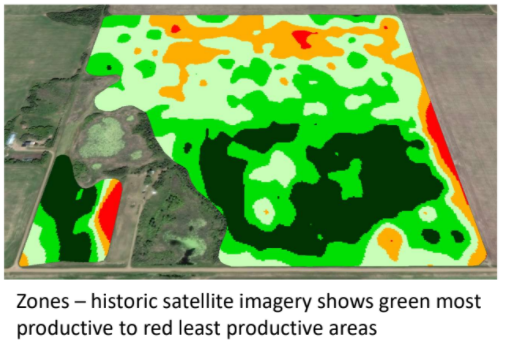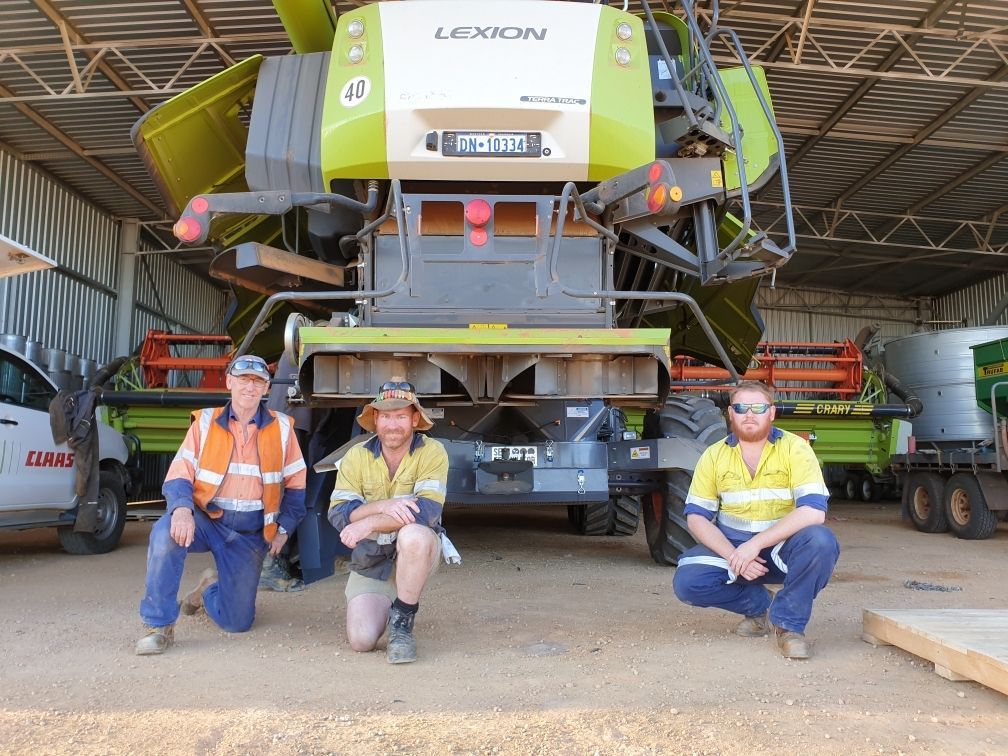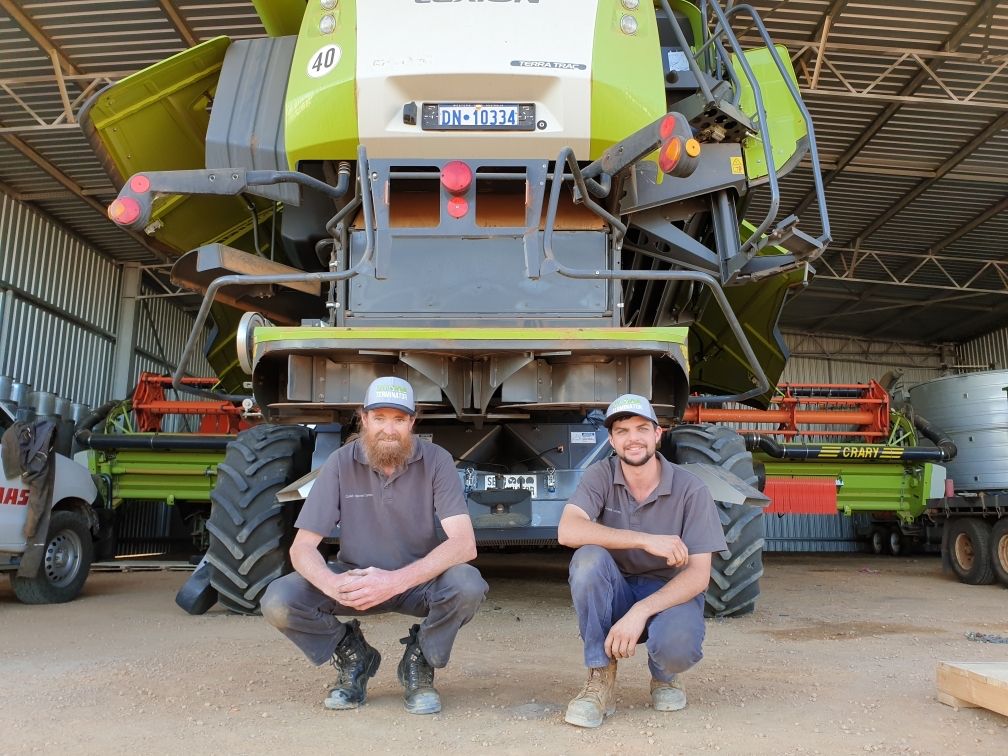|
Mark runs through his family operation, targeting his ryegrass with multiple strategies including Seed Terminator's attached to both of his Case IH combines. Mark joined Nick in 2014 with the original prototype UniSA PhD machine, adding a Seed Terminator to his operation in 2017 and then trading the 2012 prototype out for a new Terminator in 2021. Funnily enough, the unit is still going strong over a decade later. Nick shares "Thank you so much for your support over the years Mark. It's been a hell of a journey, and none of it would have happened without you guys sticking your neck out in the early days. Best of luck for the season!" This film was created by Matt & Honni of Ascend Films; we'd like to give a big thanks to Mark Adams and his family, with a special thanks to his dealer group Farmers Centre 1978.
0 Comments
1. Killing weeds as seeds, targeting them at their most vulnerable stage
2. Potential regulatory changes: Alternative weed seed control methods are required if chemicals are phased out. 3. Generational change: New farmers eager to explore innovative weed control approaches. 4. Herbicide resistance: Necessitates exploration of alternative weed management techniques. 5. Burning: Environmentally unacceptable for weed control. 6. Modern seeders: Handle heavy trash, reducing the need for burning and promoting sustainable weed management. 7. Full residue retention to keep nutrients in the soil 8. Smaller particles: Faster breakdown for nutrient recycling in soil. 9. Improving agricultural land: Ensuring productivity for future generations. 10. Cost savings: Reduced spraying expenses. 11. Fewer passes: Minimised soil compaction. 12. Terminate losses: Eliminate volunteers for improved application during spraying. 13. Long-term benefits: Reduced farmer exposure to chemicals, promoting safer practices. 14. Maximising existing land: Optimizing productivity with rising land costs. 15. Time savings: Integrated harvesting and weed control for labour efficiency. 16. Reduced chemical application: Minimised residues in the food chain. 17. Greater yields: In-crop spraying affects grain development, reducing yield. 18. Operator awareness: Aware of settings during harvesting to minimise grain loss. 19. Preventing weed competition: Protecting nutrients and moisture for crops. 20. Pest management: Less grain on the ground reduces pest infestations. 21. Improved emergence: Reduced trash promotes better crop establishment. 22. It doesn’t make sense to spend time and money killing weeds all year, only to reward the survivors at harvest and spread them out to spray next year. Article originally posted on the GRDC GroundCover written by Nicole Baxter Damien Schneider’s investment in harvest weed seed control is part of an integrated strategy he uses to drive down the population of herbicide-resistant annual ryegrass on his farm.
The southern New South Wales grower produces grain and prime lambs with his wife Carissa across 1100 hectares near Culcairn. He bought a Seed Terminator® in 2019 after trialling and ruling out narrow windrow burning, chaff lining or chaff tramlining. After analysing the costs, Damien decided a dual-impact mill system was something he could not do without. “When I saw how much ryegrass seed exited the harvester after cutting half a paddock for hay and harvesting the rest, we had to do something about it,” he says. Damien estimated that a dual-impact mill would cost about $35 per hectare on average over three years to repay. On top of this cost, he estimated additional fuel consumption for his Case IH 7230 Class 7 harvester of three to four litres/ha. With herbicides now costing some growers more than $70/ha per year, he views the impact mills as a cost-effective tool for helping to manage ryegrass. He says there were no problems fitting the mills to his harvester. When working in canola, the harvester requires more power, mainly because of the extra canola chaff going over the sieves. The mills work well in cereals, he says. However, he removed them when direct-heading late-sown canola and lupins to prevent green material from jamming the mills. Damien says his stripper front and impact mills work well together. “The mills need about 58.8 kilowatts, which is about 80 horsepower, but the stripper front frees up about the same amount of power because the harvester has to process less straw,” he says. “The efficiency gain we saw in terms of tonnes per hour, fewer harvester hours, less fuel used and reduced labour was phenomenal.” While Damien was initially concerned that his stripper front might not gather all weed seed escapes, a University of Sydney study with GRDC investment confirmed that there was comparable seed collection to draper fronts. “When I see weeds in paddocks when harvesting, I lower the front and chase them so that the mills smash the weed seeds into dust,” he says. “The airflow from the mills enables us to spread a layer of fine dust evenly across the full 12-metre width of our harvester front.” After three years, he replaced the original mills with a new set before this coming harvest. While his herbicide use has not yet changed, Damien says he has not needed to plant oaten hay on paddocks for the past two years to reduce the weed seed population. This year he has chosen to grow the mid-maturing hybrid conventional canola Nuseed® Quartz on some paddocks because the annual ryegrass seedbank is so low. In the future, he hopes to reduce his reliance on expensive herbicides and add more diversity to his crop rotation with fewer weed blowouts in subsequent crops. When it comes to helping farmers win the battle against weeds while reducing reliance on chemicals, you might say one South Australian company is crushing it. Adelaide-based Seed Terminator produces a mechanical device of the same name which pulverises weed seeds at the harvesting stage, before they get the chance to grow up and run riot among crops. This week they manufactured their 500th machine and marks a milestone for South Australian Manufacturing and Australian Farmers alike.
The brainchild of the company’s co-founder, farmer/inventor Dr Nick Berry, the Seed Terminator tackles a problem inherent to crop farming: the fact the harvesting process is the weed’s best friend. Because when the crop is cut, once the chaff and grain have been separated, the harvester flings the chaff back onto the ground. This includes the seeds of weeds that have escaped or resisted the various stages of herbicide spraying – in other words, the toughest customers of all. When these survivors are redistributed, the whole harvesting process has simply set farmers up for problems the following year. ‘Problems’ may be an understatement. In 2016 Australia’s Grain Research Development Council estimated that weeds cost Australian grain growers about $3.3 billion annually, and – because weeds deprive crops of sunlight, water and important nutrients - yield losses of 2.76 million tonnes. They also put the cost of herbicide resistance at $187 million a year, for herbicide treatment and other weed control practices. Repeated use of the same herbicides has led to herbicide resistance. A small minority of weeds of one particular species, thanks to a slight genetic variation, would be resistant to the herbicide. Over years of using the same herbicide, these survivor weeds would flourish and eventually dominate. The herbicides needed to be used more often and in stronger doses. Nick’s invention is a smart and cost-effective solution. The Seed Terminator is an attachment that retro-fits to most combine harvester brands, and it uses multi-stage hammer mills to pulverize weed seeds along with the chaff so they can’t sprout. What's left is a fine sawdust-like mulch that actually puts nutrients into any soil that it’s spread upon. Installed on a typical harvester, the system can distribute that mulch up to 14 metres. It’s a one stop weed killer and mulcher as well as grain harvester. “We’ve got farmers who are anywhere from 600ha to 20,000ha and they all run different brand harvesters and different size ones, but they all have sustainability issues with herbicides. They need an integrated approach, to be using herbicides but to protect them from resistance, and drive down the weed population with something mechanical. Our vision is to reach as many farmers as possible, as quickly as possible and as economically as possible. Affordability is really important. While we develop the tech, we also need to reinvest in making it better. The first pilot Seed Terminators were introduced in 2016, and now there are 500 machines in operation worldwide, each retailing for around $115,000. The units utilise innovative manufacturing techniques developed in conjunction with manufacturing partners in Adelaide. Director Mark Ashenden shares “we are a proud South Australian company, with the Seed Terminator designed, tested, manufactured and shipped globally from right here in Adelaide.” Seed Terminator also conducts ongoing trials in a number of universities in both Australia and overseas to test the ability to kill weeds. The University of Adelaide testing found the device able to kill 99% of notoriously tough ryegrass seeds, with this result recently backed up again in 2021. “Seeds come in different shapes and sizes so you need to apply different amounts of energy to kill them.” While the Seed Terminator is getting uptake in Europe, Canada and the USA, Farmers in Australia are very innovative. “Farmers care deeply about their land and its ability to produce food for the world. That long-term attitude isn’t only in Australia but it is pretty unique.” “It’s a generational thing – they want to hand down the farm to their kids and grandkids.” “Farmers see the issue. They see it doesn’t make any sense to spread weeds with their harvester,” says Nick. “With Seed Terminator, they are getting revenge on their weeds." Meanwhile, Nick sees it as Seed Terminator’s mission to stimulate change, through commitment to R&D and developing further mechanical solutions to help farmers protect their crops. “We’re not only looking at how we can smash seeds but the whole system - how can we mechanically intervene to make farming more sustainable. We want to look at this holistically.” Damien Gooding runs through his family operation in Dumbleyung Western Australia, targeting his ryegrass with Seed Terminator's attached to both of his Case IH combines. Damien joined us in 2017, with a second unit added to his operation in 2021. This film was created by Matt & Honni of Ascend Films; we'd like to give a big thanks to Damien and Megan Gooding, his brother Ross Gooding with a special thanks to his dealer group Farmers Centre 1978 and Brett Asphar. Keep an eye out for their "Red Tractor Wheat Free Oats" in your local supermarket, grown on their farm and distributed nationally. Seed Terminator is on a mission to change agriculture globally. Dr Nick Berry shares why mechanical weed control is integral to the future of farming and discusses the sustainability of herbicide applications and preservation of the chemicals that allow farmers to produce enough food to feed the world.  After the biggest harvest on record, West Australian farmers should be congratulated on their work to make the best of the season, with 22 million tonnes delivered. Now, onto making the best of the 2022 season with record high input costs, is now the time to add a Seed Terminator to your weed control toolbox? Agriculture in Western Australia is enjoying a rapid growth trajectory based on ever-increasing demand for food. Western Australian farmers have always been known for their ability to diversify and innovate based on upstream and downstream forces. Facing an ever-increasing demand for food; innovations like Seed Terminator are critical in capturing every marginal efficiency available. For North American and European manufacturers Australia, particularly Western Australia, is viewed as a global breaking ground for new tech. Tom Slatyer, new commercial manager for Seed Terminator shares “that’s one thing that drew me to Seed Terminator, they are reversing the flow. It’s homegrown aussie innovation, taking disruptive technology to the world and transforming how growers everywhere manage weeds.” “I’m proud to be a part of that narrative and I feel it’s just the beginning.” Growing up in the southwest, Slatyer was lucky enough to enjoy the lifestyle of a close-knit regional community and cultivated a lifetime passion for working in ag with a focus on broad-acre dry-land cropping. With experience across the board in agriculture, he started with a placement in a Wongan Hills dealership which led onto a Territory manager position with Hardi Australia. More recently, working in grain marketing, he gained valuable insights from the opposite side of the ledger, “I’m so grateful for the skills and experiences that WA Ag has rewarded me.” Slatyer shares he “is looking forward to helping growers make the right investment when entering the HWSC space. A mill isn't just a mill - Seed Terminator are the innovators in the market.” “Recent benchmark studies completed in 2021 confirm the highest kill at 99% on Australian Ryegrass, certifying their ability to deliver the market leading kill rate, it’s a brand that you can trust.” https://www.dropbox.com/s/0j6cov3g8ogkxg5/Seed%20mill%20benchmark%20testing%202021_090821.pdf?dl=0 “I’d hate to see growers burning extra time and diesel during harvest for a subpar result, there’s too much at stake.” Local farmer David Hesford invested in the technology for his family operation near Northam, purchasing the unit through CLAAS Harvest Centre Northam branch. When asked why he chose a Seed Terminator over other options on the market, David said he “likes to buy Australian owned wherever possible” and shared that in combination with the quality of the product, long lasting mill components and ease of use, it was an easy decision. He shares other farmers' concerns about weed control in the future, with concerns that there may be bans on burning and restrictions on chemical applications, “it's just another tool in the kit, we really need to get on top of weeds now. This is the time.” Alongside Product Specialist Brett Asphar, Tom looks forward to further entrenching Seed Terminator’s presence in Western Australia. A new facility in Canning Vale will bolster the companies ability to deliver class leading support to all stakeholders, and provide a base of operations that will facilitate dealer training and grower days. While so many providers have pulled out of WA to consolidate over east Slatyer shares “I view this investment as a strong statement to our commitment to WA.” He states “as we scale up there will be scope to increase our technical support network in WA. For those with relevant industry experience and interest in working with a passionate team who value work-life balance, and support personal and professional growth, we want to hear from you.” Brett Asphar, Seed Terminator integration expert shared that this was a challenging harvest. With crop bulk, density and material quality, leading to high sieve and mill loadings across all brands. Not to mention green material, which is traditionally not present across the wheat belt “we learned so much about harvester optimisation in big crops, last years modifications saw a performance gain in this years harvest, every little bit was worth it.” Big thanks to our dealer network, for their continued support, this was our 6th harvest in Western Australia. For those who have already invested in Seed Terminators, farmers can expect a parcel in the post at the end of February with the team seeking feedback on the harvest that was. Marketing Manager Kelly Ingram, based out of the Kangaroo Island office shares “the harvest feedback we gather from farmers using the product is critical to our research and development, we’re constantly learning, year on year, since we started in 2016.” The Seed Terminator can be fitted to select CLAAS and Massey Ferguson models, New Holland CR models, all flagship Case IH models and all John Deere S series machines. To secure a Seed Terminator under the Early Order Program, get in before 28th February 2022 to ensure pre 30 June delivery and to take advantage of tax savings. Featured in Farm Weekly February 2022 Key Points • On-farm trials reveal losses from chemical use • Seed Terminator helps to stop the spread of weed patches • Plans to fit two more Seed Terminators to combines On-farm trials in Canada are demonstrating the benefits of the Seed Terminator for broad spectrum weed control and slowing the onset of herbicide resistance in cropping operations. Josh Lade has been farming at Osler, Saskatchewan, for 10 years after migrating there from Australia. One thing that has piqued his interest since he has been farming in Canada is the impact of herbicides on crop yield. “One of our main weeds of concern here is wild oats,” Josh said. “As herbicide resistance becomes more prominent, some growers are finding that new chemistries coming to market also come with heavy crop tolerance impacts. “I have been finding that while grass selective sprays are important, over-applying them is impacting crop yield.” Josh has been conducting on-farm trials to test this theory. In a wheat crop during the 2018 season, Josh found there was 4.9 bushel per acre yield penalty in areas where there was a grass spray compared to areas where there was no grass spray. With a wheat price of $7 per bushel and a chemical price of $12 per acre, this yield penalty worked out to be $46/ac. He ran the same trials in 2020 which resulted in a 2.8bsh/ ac yield penalty between sprayed and non-sprayed areas, resulting in a $38/ac penalty including the cost of the chemical. The penalty was even greater in barley. Averaged across five repetitions, the yield difference was 6.4bsh/ac, resulting in a penalty of $42/ac. “We have often seen a tolerance to herbicides but we have never seen it as a yield impact, only as impeded growth during the season,” Josh said. “It is only since doing these trials I have realised that, depending on the herbicide, the impact could be between 6-7bsh/ac. Other ‘safer’ herbicides could be costing us 3bsh/ ac in yield.” Josh was one of the first growers in Canada to adopt the Seed Terminator, a mill which attaches to a combine harvester and terminates weed seeds before they enter the paddock and become problem weeds. He believes the Seed Terminator is vital in helping to stop the spread of weeds, such as wild oats, and therefore reducing the size of the patches of weeds requiring a grass selective herbicide. “Grass selective herbicides are still an important tool for us as growers, but I believe we need to adopt a layering approach in order to slow the onset of herbicide resistance and lessen the impact on the crop,” Josh said. “The first of those layers is a residual herbicide and then use a grass selective on the areas only where it is needed. That might only be 10 per cent of a paddock, but currently we are applying a blanket approach to the whole paddock and potentially compromising yield on the other 90 per cent of the paddock that does not need a grass selective. “The Seed Terminator will help to stop the spread of that problem patch of weeds and we know that wild oats stays in patches because of the way it drops seeds.” Seed dispersal of wild oats is a particular problem for growers in Josh’s area. Research conducted at the University of Saskatchewan by Shirtliffe (2009) examined the distance combine harvesters can disperse wild oats seeds and the effect of chaff collection on combine harvester seed dispersal.This research showed that chaff collection consistently reduced the amount and distance wild oat seeds were dispersed because more than 74 per cent of the total wild oat seeds were ejected from the combine in the chaff. “By running a Seed Terminator for about $10/ac, we could be stopping the dispersal of weed seeds and getting broad spectrum weed control while slowing the onset of herbicide resistance and lessening the impact on the growing crop,” Josh said. Besides wild oats, which Josh says is the most costly weed for him, other problem weeds include cleavers and kochia. While Josh admits he was nervous the first time he tried the Seed Terminator in Canada, the results he has seen since that first run in 2018 have filled him with confidence. “Conditions here can go from 20 degrees Celsius to -20 degrees Celsius and we can still be harvesting,” he said. “For that reason, I was thinking we might encounter some issues but we’ve never had to take the Seed Terminator off. “We are currently running two mills on two harvesters and we plan to fit two more this season and run them on all four harvesters. “I’m confident Seed Terminators will cost the average farm in Canada between $8/ac and $12/ac, which is a far cry from the $40-plus/ac some of the in-crop grass selective herbicides are costing.” References: Shirtliffe, Steven. (2009). Chaff collection reduces seed dispersal of wild oat (Avena fatua) by a combine harvester. Weed Science. 53. 465-470. 10.1614/ WS-03-109R2.
Just twelve months on from their 200th milestone, the South Australian based
company Seed Terminator is celebrating their 400th machine, and they’re not stopping there with number 430 rolling out of the factory late last week. Local farmer David Hesford invested in the technology for his family operation near Northam, purchasing the 400th unit through CLAAS Harvest Centre Northam branch. He shared he has always been keen on a Seed Terminator but didn't have the header to do the job until this harvest when they made a big leap upgrading their combine and investing in a Terminator all in one go. He had been following the introduction of mill technology since the original hydraulic version and was watching the development of the technology to the proven platform it is today. When asked why he chose a Seed Terminator over other options on the market, David said he “likes to buy Australian owned wherever possible” and shared that in combination with the quality of the product, long lasting mill components and ease of use, it was an easy decision. He shares other farmers' concerns about weed control in the future, with concerns that there may be bans on burning and restrictions on chemical applications, “it's just another tool in the kit, we really need to get on top of weeds now. This is the time.” Cameron Page, Sales Manager at CLAAS Harvest Centre Katanning shares “the uptake of the Seed Terminators on both 700 & 1000 Series CLAAS LEXION Combines in the Great Southern region is increasing each year. The units perform in the field and our customers have been reaping the benefits.” He feels the businesses are well aligned with customer satisfaction and safety front of mind. Attached to the back of the combine harvester, the Seed Terminator mechanically pulverises the chaff and weed fraction, and kills 99 per cent of weed seeds. Recent benchmark studies completed in 2021 confirm the highest kill at 99% on Australian Ryegrass, backing up previous independent weed kill testing results. This is backed by a paddock proven platform, with over 900 harvests under their belt spanning three continents. The design is a mechanical system that uses the harvester’s drive to transfer power to two multi stage hammer mills. These grind, shear and pulverise the chaff once it has been separated out from the grain – ensuring even the toughest weed seeds won’t be back. “Mechanical seed control is not a silver bullet but an incredibly useful tool on the tool belt in preventing or dealing with herbicide-resistant weeds by reducing the weed seed bank,” said Ned Jeffery, commercial manager for Seed Terminator. “It’s about reducing the weed seed count carry over into the next season and increasing the lifespan of the chemicals,” he said. Amidst assembling and shipping the Seed Terminator team paused late last week to celebrate dual milestones with September bringing the company's 5th birthday. The new Seed Terminator Lonsdale Factory ensures uninterrupted supply of the proven platform offering quality, availability and prompt shipment of spare parts. CEO Paul Sandercock shares “sourcing Seed Terminator components is done up to 12 months in advance, we’re in a fortunate position to be uninterrupted by the covid pandemic interruption to supply. The consolidated distribution and integration of operations into a new facility at Lonsdale SA, with the capability of distributing up to 600 machines per annum is very exciting.” The unit can be fitted to select CLAAS and Massey Ferguson models, New Holland CR models, all flagship Case IH models and all John Deere S series machines. Seed Terminator has John Deere and Case IH units available now, with shipments going out across Australia daily right through harvest. The team at Seed Terminator know they are celebrating this success because of the partnerships they’ve developed in South Australia, Australia and overseas and wish to extend a big thanks to all those involved. Keep it unbiased, simple, efficient and repeatable = Increased confidence in testing results with David Brunton from The Adelaide University’s Weed Science Research Group
|
Kelly IngramArchives
July 2023
Categories
All
|
Home
Seed TerminatorConversations with Farmers |
© COPYRIGHT 2020. ALL RIGHTS RESERVED.
|






 RSS Feed
RSS Feed